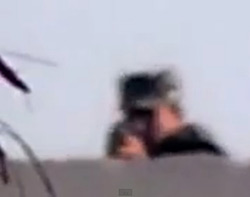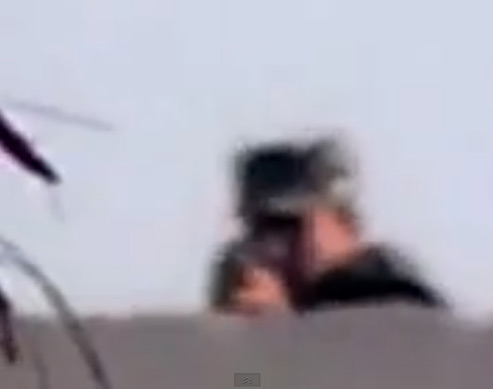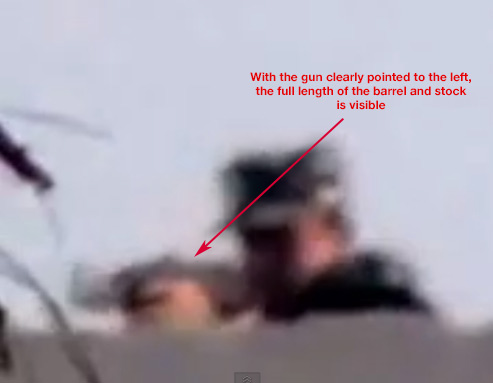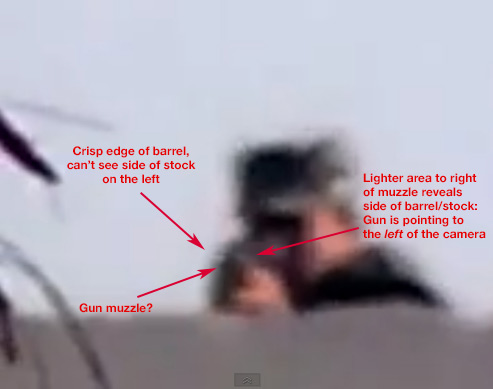Sniper video: Did a photographer really capture the moment of his own death?
posted Friday, July 12, 2013 at 2:04 PM EST

In a video that's gone hugely viral in the past couple of days, Egyptian photographer Ahmed Samir Assem allegedly captures the moment of his own death as a rooftop sniper appears to take aim and shoot him. The idea that someone could record his last seconds alive adds immeasurably to the underlying horror of trained shooters firing on civilians.
It's certainly a remarkable piece of video -- or is it? Does the video really capture the shot that killed the photographer?
After closely examining the footage in question, I don't think it does.
Watch the video below, and read on for my reasoning. Feel free to add your own thoughts and comments in the discussion area at the end of this article.
Before I get into analyzing the video, though, let me first begin by stating clearly that: a) I deplore force being used against unarmed demonstrators, and b) I am not for a moment claiming that photojournalist Ahmed Samir Assem wasn't killed by a gunshot sometime around when the video was captured. He might very well have recorded that video, and he may very well have been shot by the sniper shown in the clip. I just don't believe the clip shows the moment he was actually shot. (At least, not if he was the person recording the video.)
When it comes to the question of whether the video captures a shot that killed the person filming it, I think there's a lot of room for doubt. The two critical questions are:
- Does the video in fact ever show the sniper's rifle aimed at the camera/photographer?
- Could the camera equipment claimed to have been used actually record the video as shown?
Since the rest of my discussion here is so long, I'm going to leave the second question above to others. (For the record, though, my personal belief is that it couldn't have.)
In the video, the sniper in question repeatedly pops up from behind a roof parapet, takes a shot or two and then ducks back. In the final frames, he appears to turn towards the camera, after which the video quickly ends -- the implication being that the (presumed) shot ends both the recording and the photographer's life who captured it.
There's only one problem: The gun is never pointed directly at the photographer or his camera. Check the screen grab below:

Wow, it sure looks like that guy is pointing a gun at you, doesn't it? But ask yourself: What would you see if a gun were aimed directly at you? The muzzle, of course, but anything else? Would you see either side of the barrel or stock? No, you'd see the end profile of the stock, but not either side of it.
To help illustrate my point, let's look at a frame from earlier in the segment, where the gun is aimed far to the left:

There's no question here, the gun is aimed way to the left, and as a result, you can see a lot of its stock and barrel. Now let's take a look at that near-final frame again:

This is the point in the video where the gun is most closely aimed at the photographer. Closely aimed, but not quite directly aimed: We can clearly see a portion of the right side of the stock (our right, the sniper's left), and none of the other side of the stock. In fact, there appears to be a point where the tip of the barrel can be seen against the sky, with no end-view of the stock surrounding it. This means that the gun is aimed at an angle, to the left of the photographer.
(To make it easy for you to step frame by frame through the end of the video, here's an .MOV file that I captured of the last few seconds of the YouTube video playing full-screen on my MacBook Pro. A standalone video player will let you single-frame through the video much more easily than you can in YouTube itself. You'll see that the frame shown above is in fact the one in which the gun is most closely aimed at the camera. Do you see anything else, right at the end? Read on below, to see if you saw what I did.)
Actually, while it's not clearly resolved enough to be definitive, there's a slightly darker spot in the image that most likely corresponds to the actual muzzle opening at the end of the barrel. If this, in fact, is the muzzle, then it completely clinches the case: For the gun to be aimed at the camera, the muzzle opening would have to line up directly below the eye of the sniper, as he sights along the barrel to aim it.
Regardless of whether that darker spot is the muzzle or not, it's obvious to me that neither of the sniper's eyes is lined up directly behind the bulk of the gun. From previous frames, we know that he's holding the gun with his left hand extended a ways along the barrel, so the position of that hand in the frame establishes the location of a point well along the barrel. He's also holding it with a U-shaped grip, his thumb extending along the barrel. This means that the barrel of the gun will be located in the picture somewhere to the left of his thumb and wrist.
Looking again at the frame shown above, it's clear that the bulk of the barrel and stock is aligned quite a bit to the left of either of the sniper's eyes. He's clearly aiming somewhere to the left of the camera. Case closed, at least in my book.
Now, about that other thing I saw, right at the end. Actually, there were two other things that caught my eye. First, if you advance the video frame by frame, you'll see that the rifle swings towards the camera, and then swings away just slightly, before the video ends. My interpretation of this is that the clip was edited from a longer one, and it was cut before it could show the rifle swinging away (and the camera still recording). It wasn't trimmed quite closely enough, though, as we can see the beginning of that motion.
(Note: There are now at least two different versions of this video out on the 'web: The original one that I've linked above is 27 seconds long, and shows the rifle swinging away from the camera in the last frame or two. A more recent version is only 26 seconds long, removing the embarrassing editing gaffe, but still retaining the white-out of the screen.)
That second thing? Watch the end of the clip, stepping through it frame by frame, and pay attention to just how it ends. Whoever edited the video probably would like us to believe the ending shows the death throes of the camera itself, flaring to white before the clip ends. I don't believe that this part is an actual recording, but was added in post instead.
Something else happens at the very end of the clip; the image quickly goes out of focus, then flares to white. Is this reasonable? Consider: What could cause the image to go out of focus quickly? It could conceivably be the result of either the photographer or camera being hit by a bullet, but if that were the case, you'd certainly expect some camera movement as well: How could the focus be changed so rapidly, literally from one frame to the next, without the camera also changing position equally abruptly? Rather than the camera moving violently, though, the image of the sniper remains in exactly the same position within the frame, it just blurs very rapidly.
There's one final clue to be found as well, but it's not quite as conclusive. The white flare at the end looks to me very much like a still image that's been spliced onto the end of the video, or perhaps a legitimate video frame that's been inserted as a still. I say this because the flare lasts for three full frames, and is completely unchanged during that time, right down to the extensive JPEG artifacts. It seems to me highly unlikely that a camera would fail in such a way that a specific and absolutely unchanging light-and-dark pattern would be preserved on the sensor surface. Not impossible, mind you, just very unlikely.
Bottom line, I don't see any way that this video can be showing the moment of Mr. Assem's tragic death.
Given how politically charged this story is, it's probably worth repeating again that I'm not at all claiming that Mr. Assem wasn't killed sometime in close proximity to the making of the video, nor that he wasn't shot by a sniper, nor even perhaps by the particular sniper shown. I have no way of evaluating any of those claims, and am not arguing against any of them.
My only contention is that the video in question doesn't show what it's claimed to, that the particular sniper shown couldn't possibly have shot whoever recorded it, in the final frames.
That's my take, at least -- what's yours?